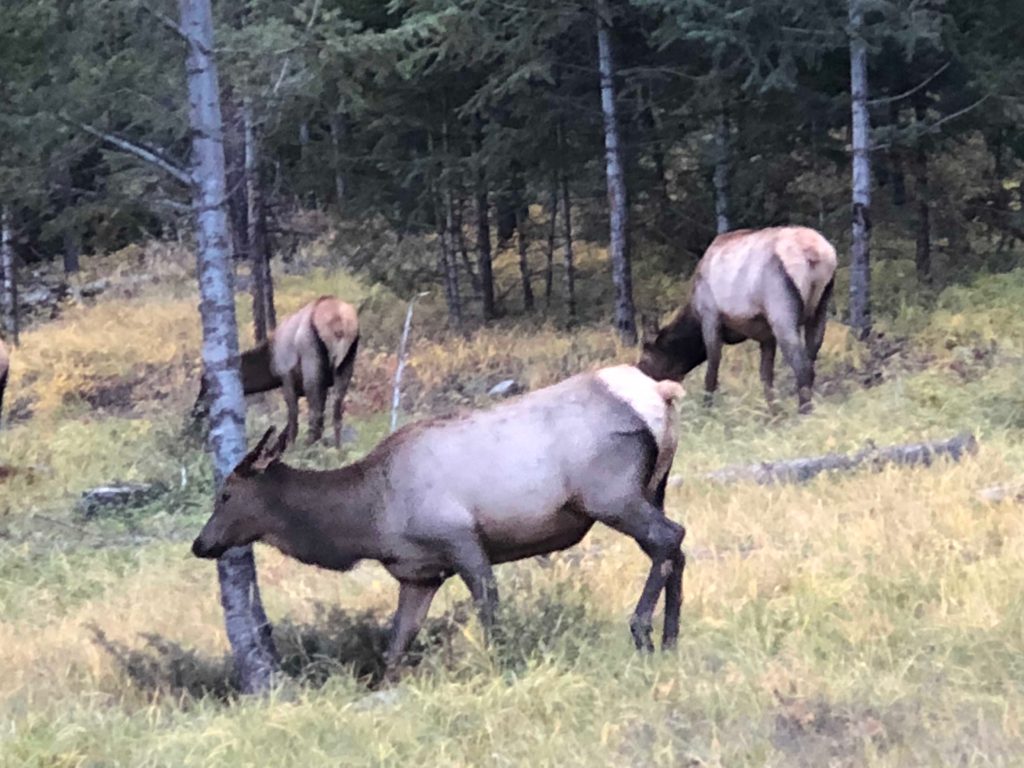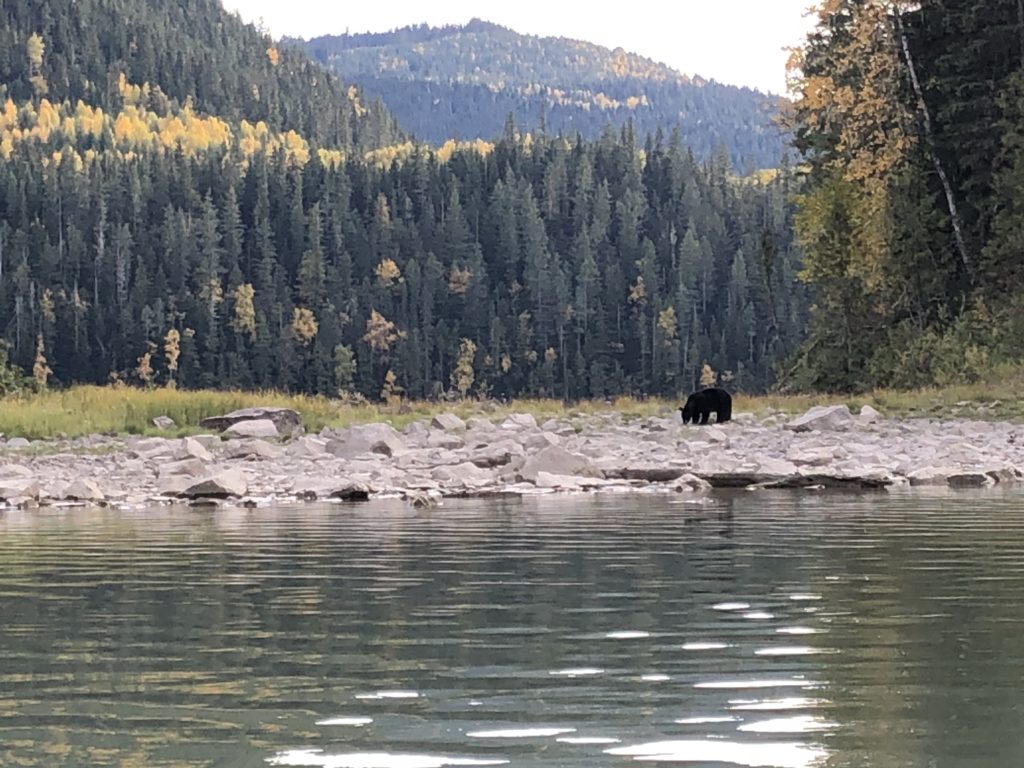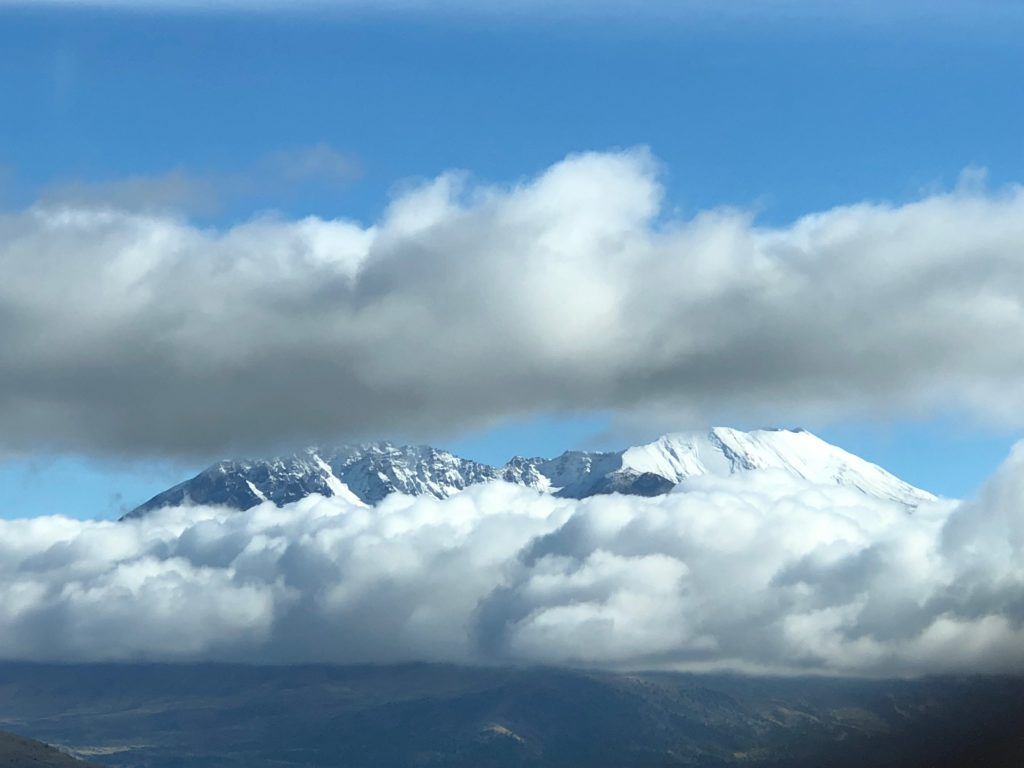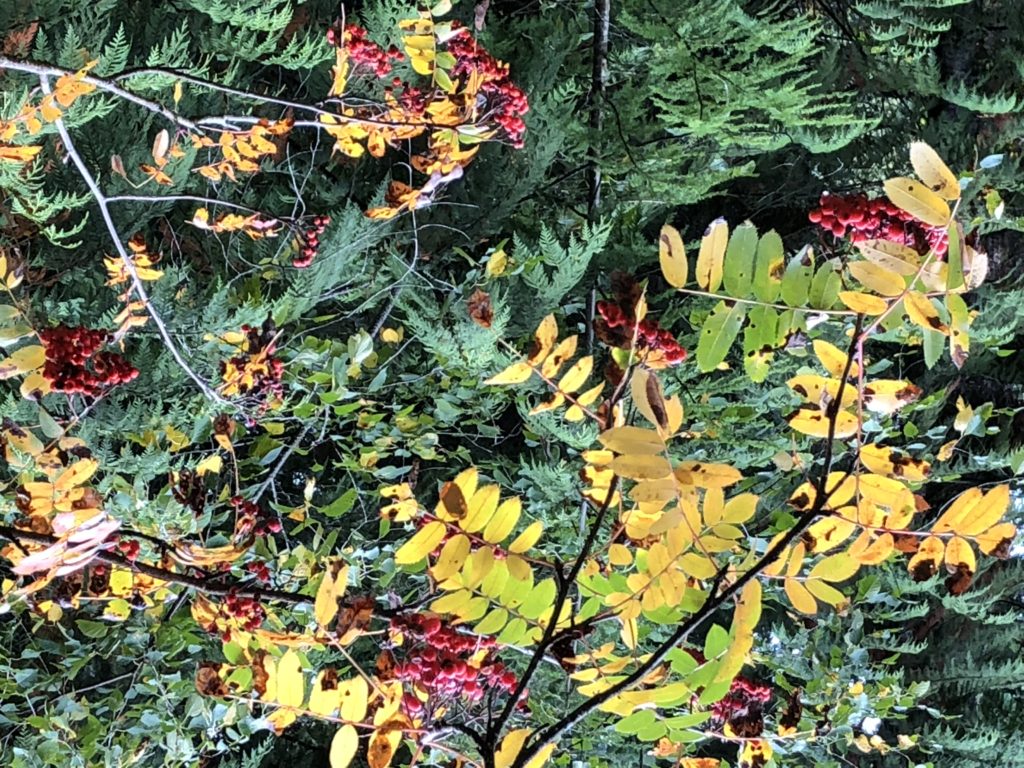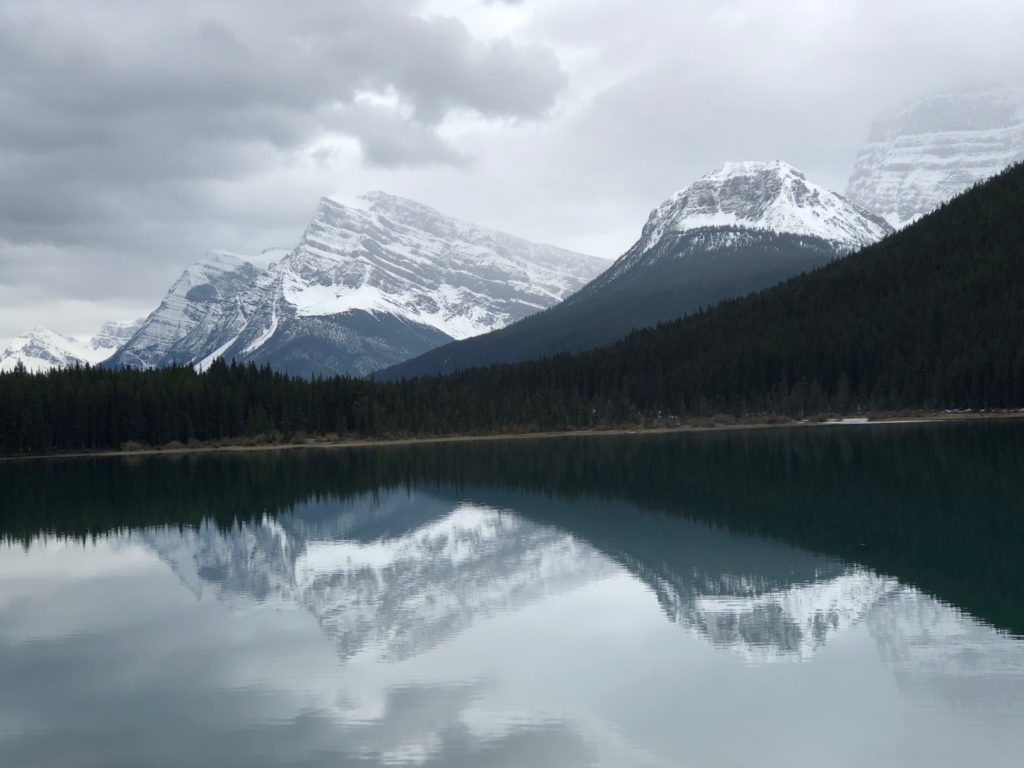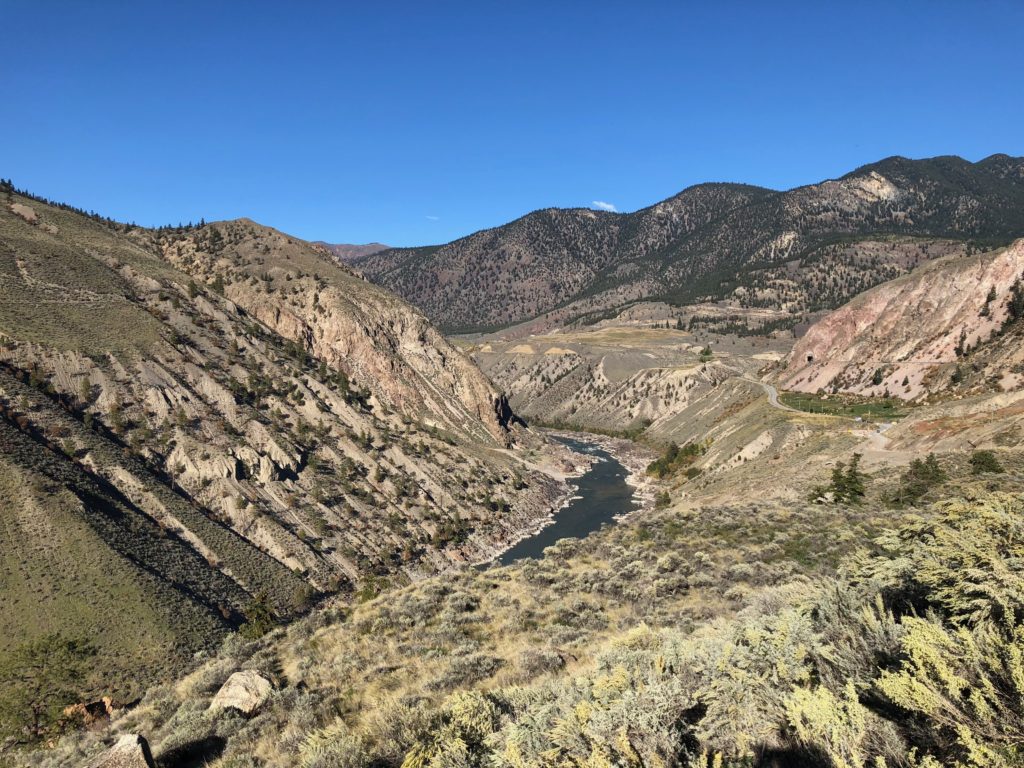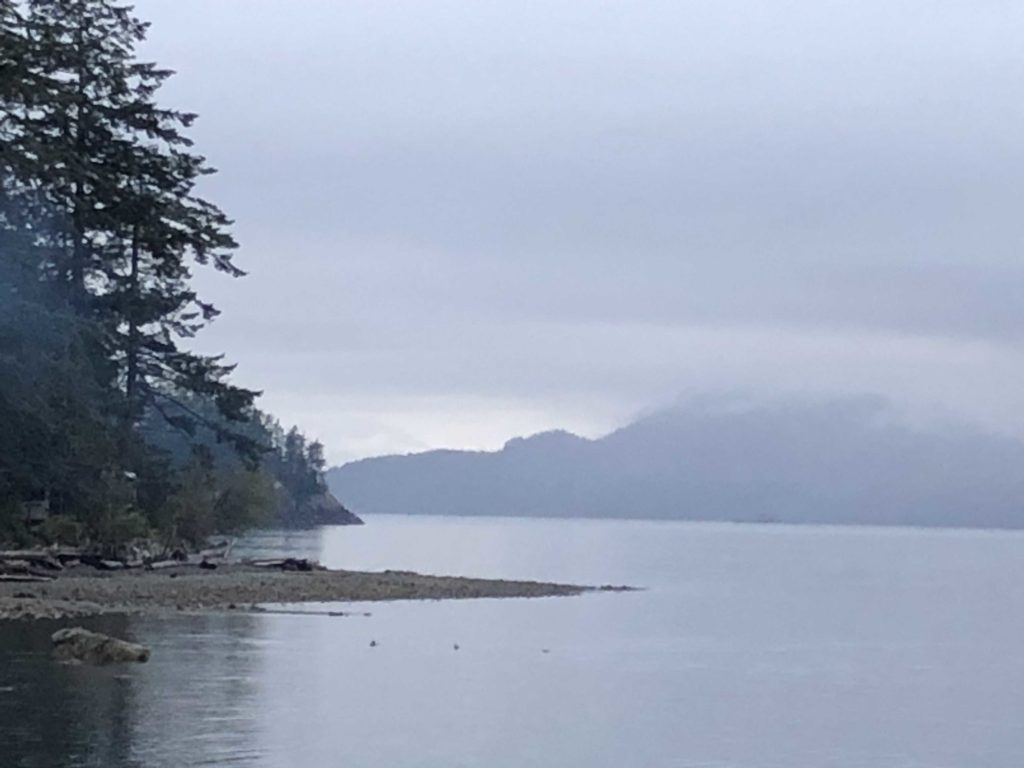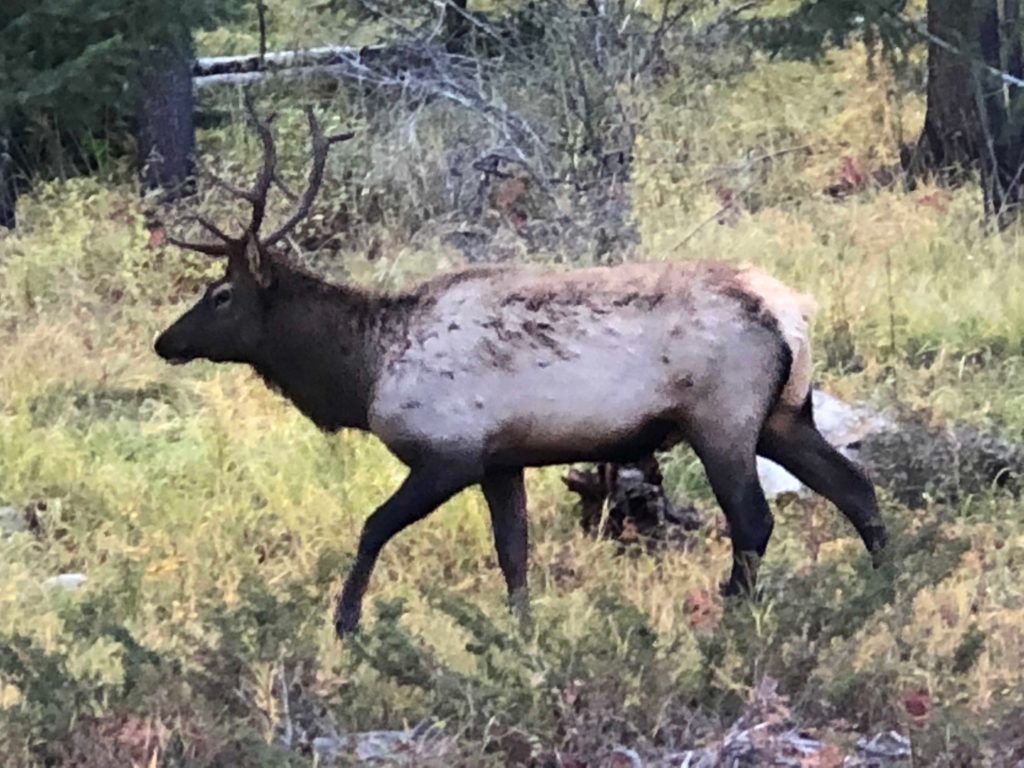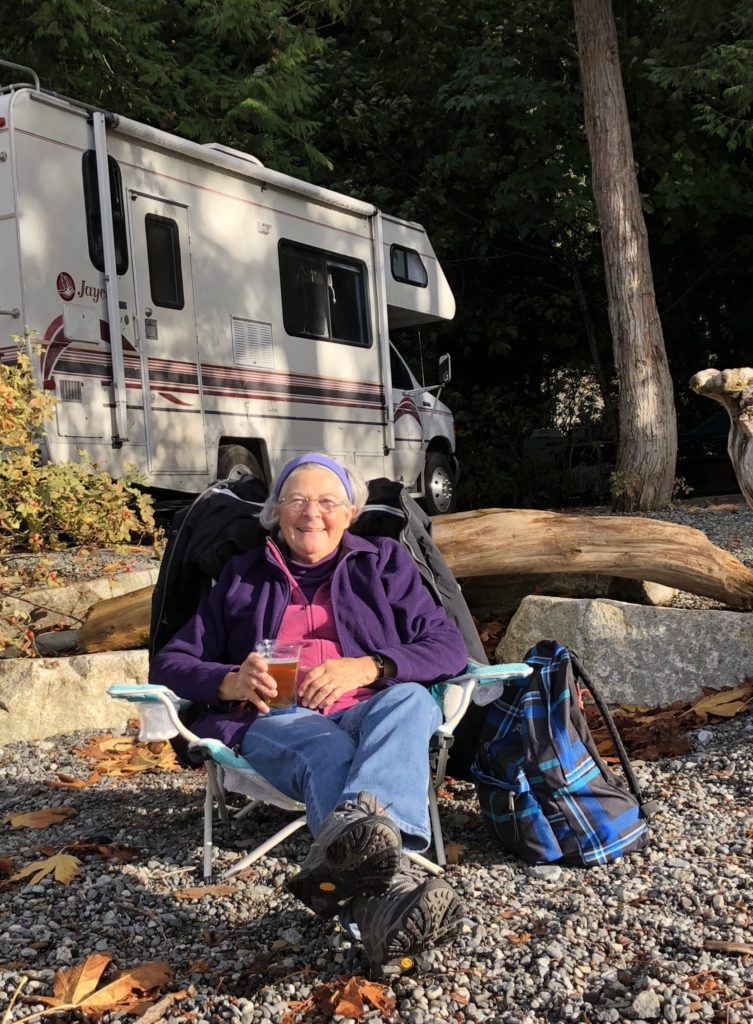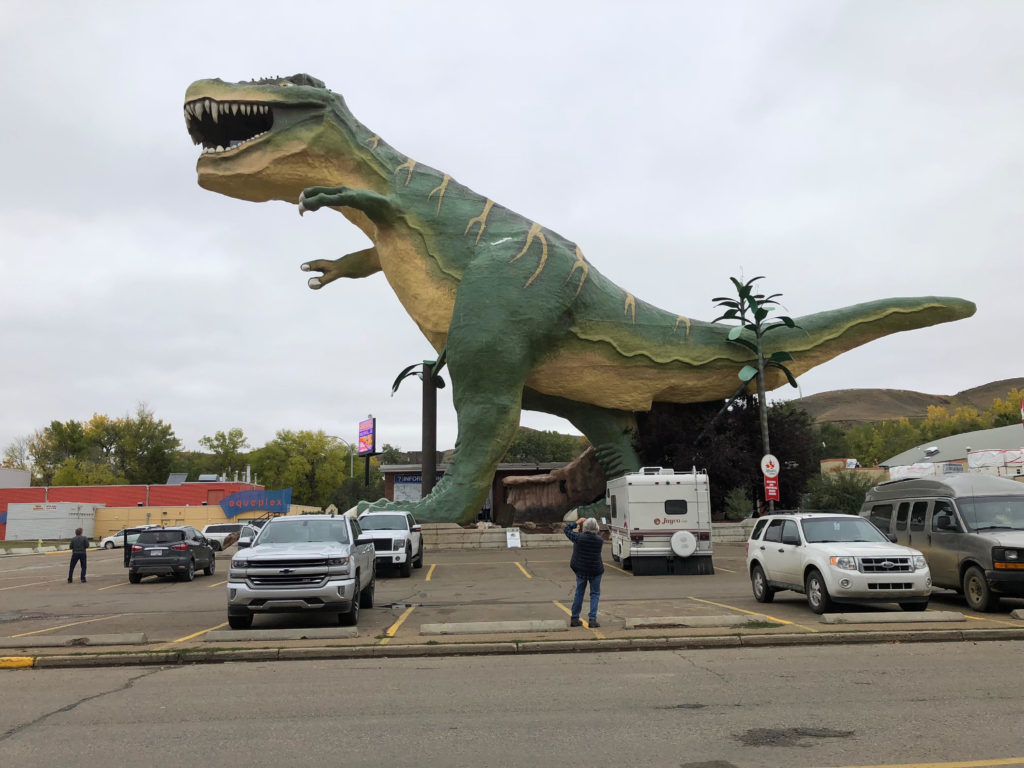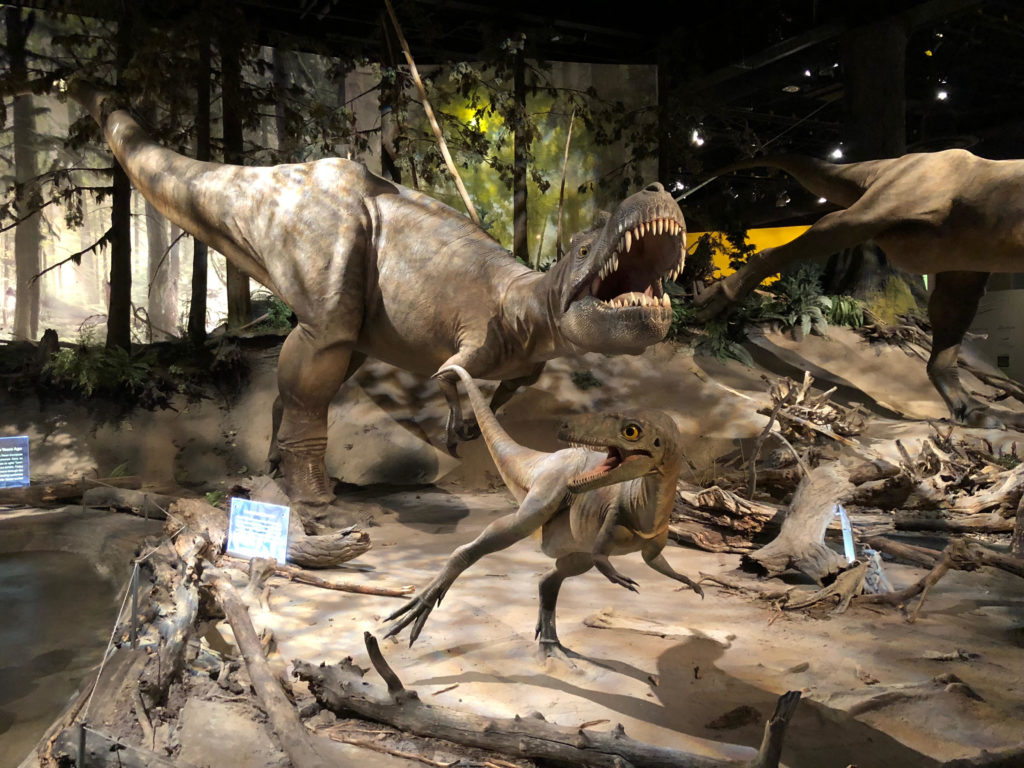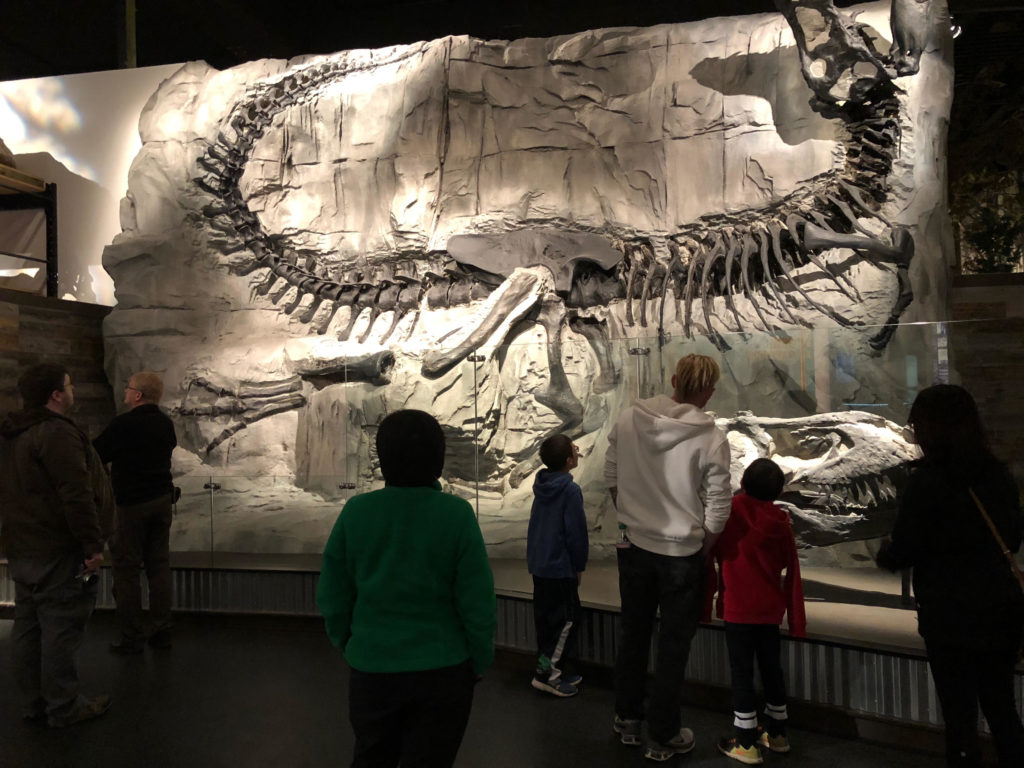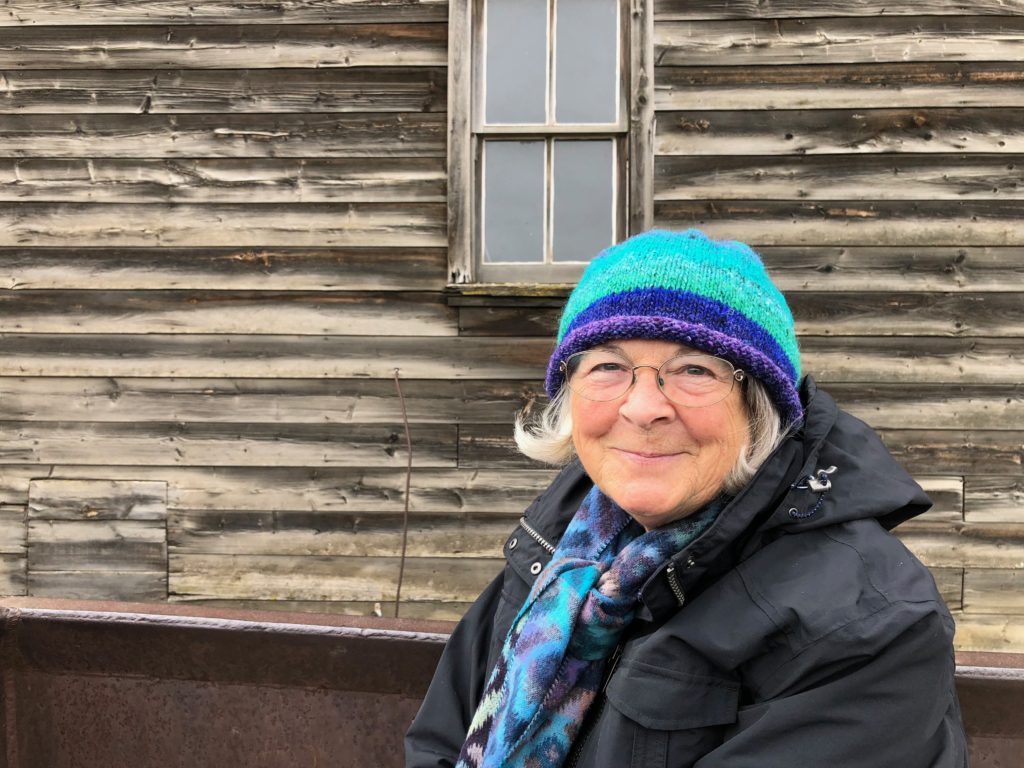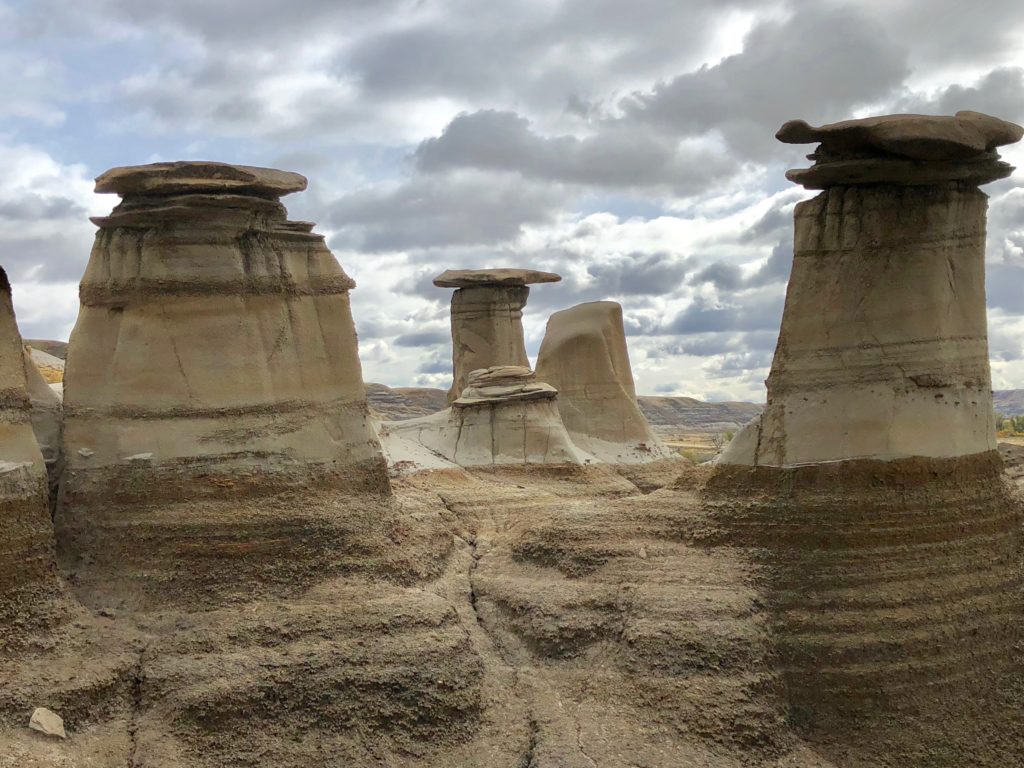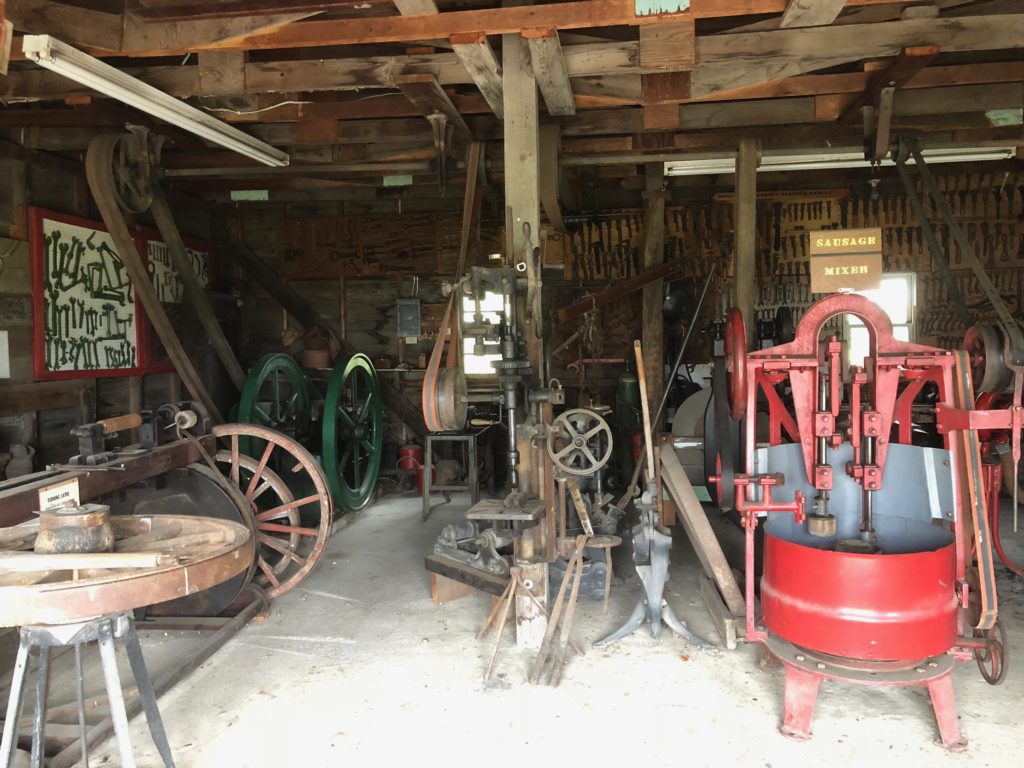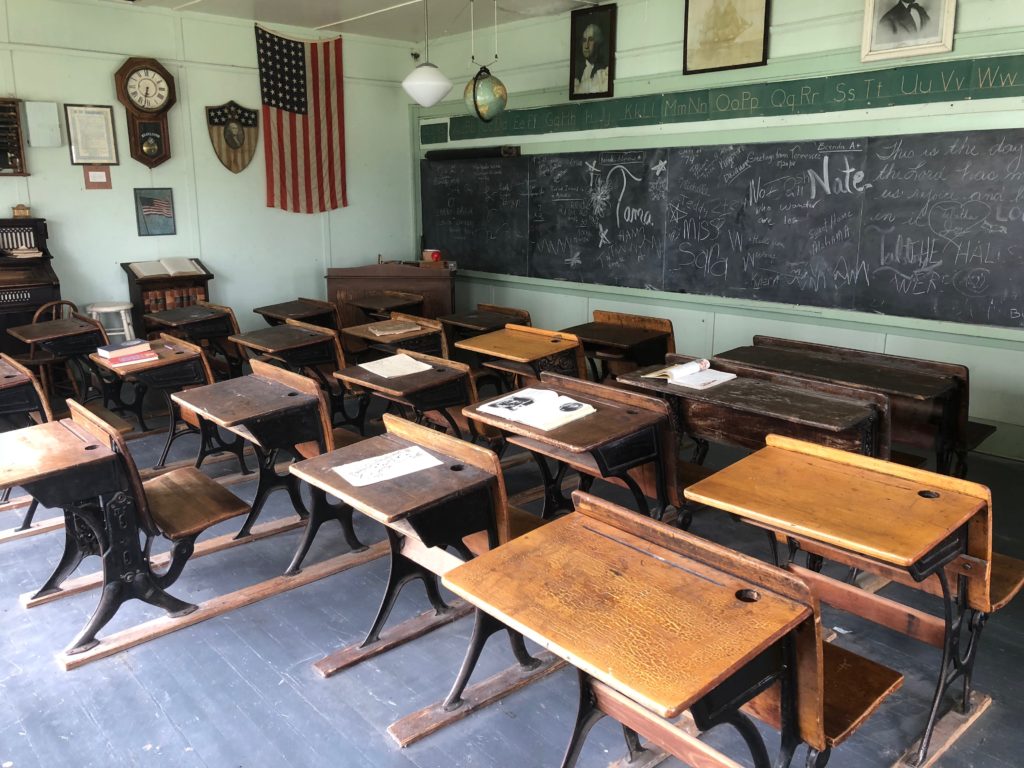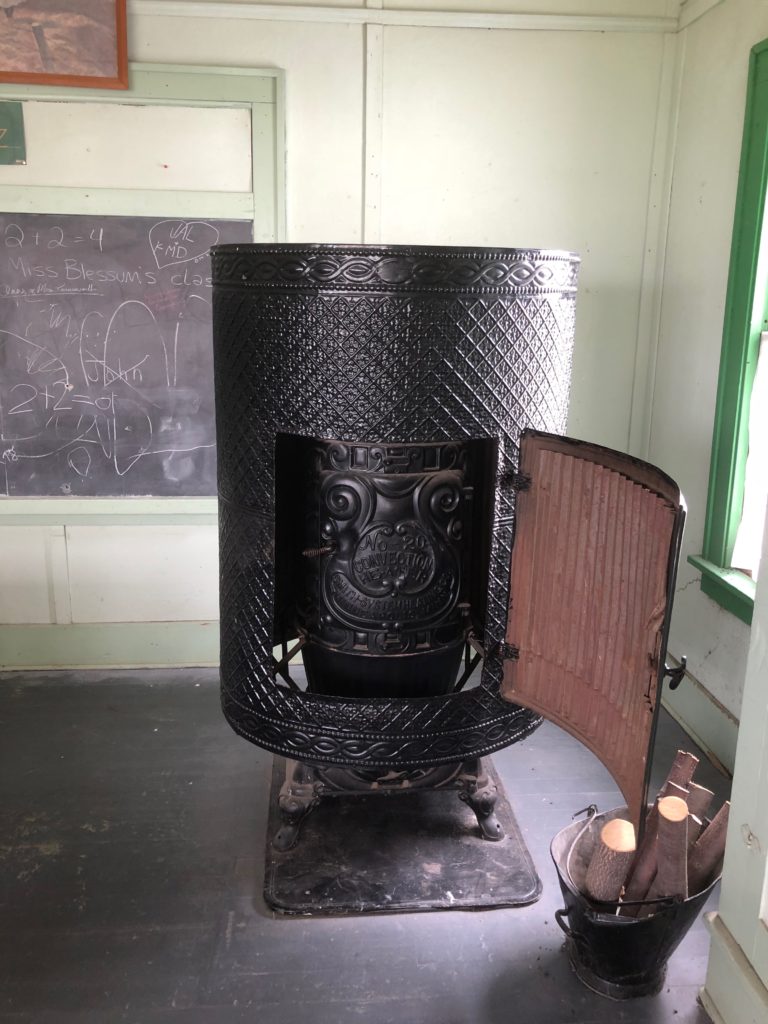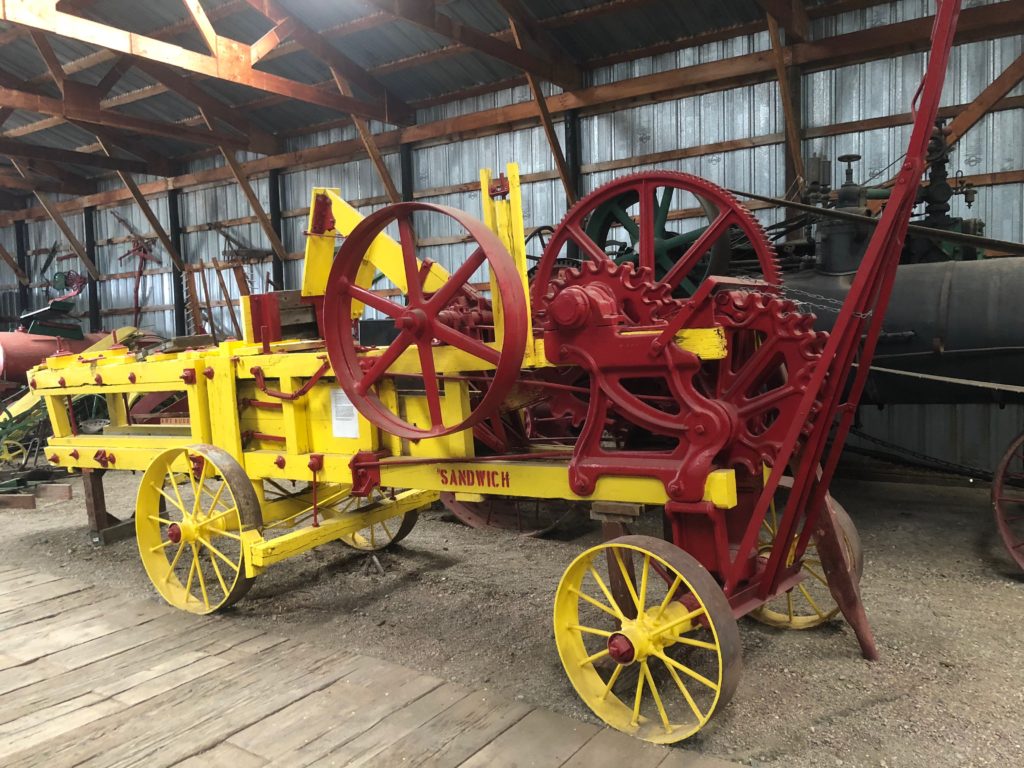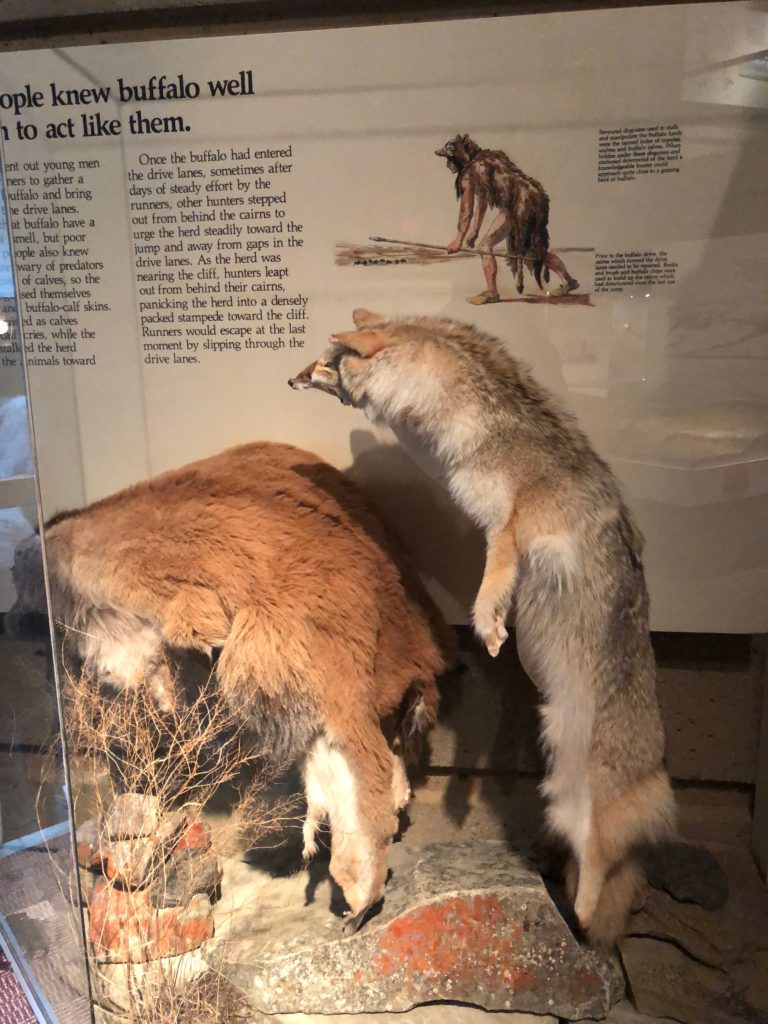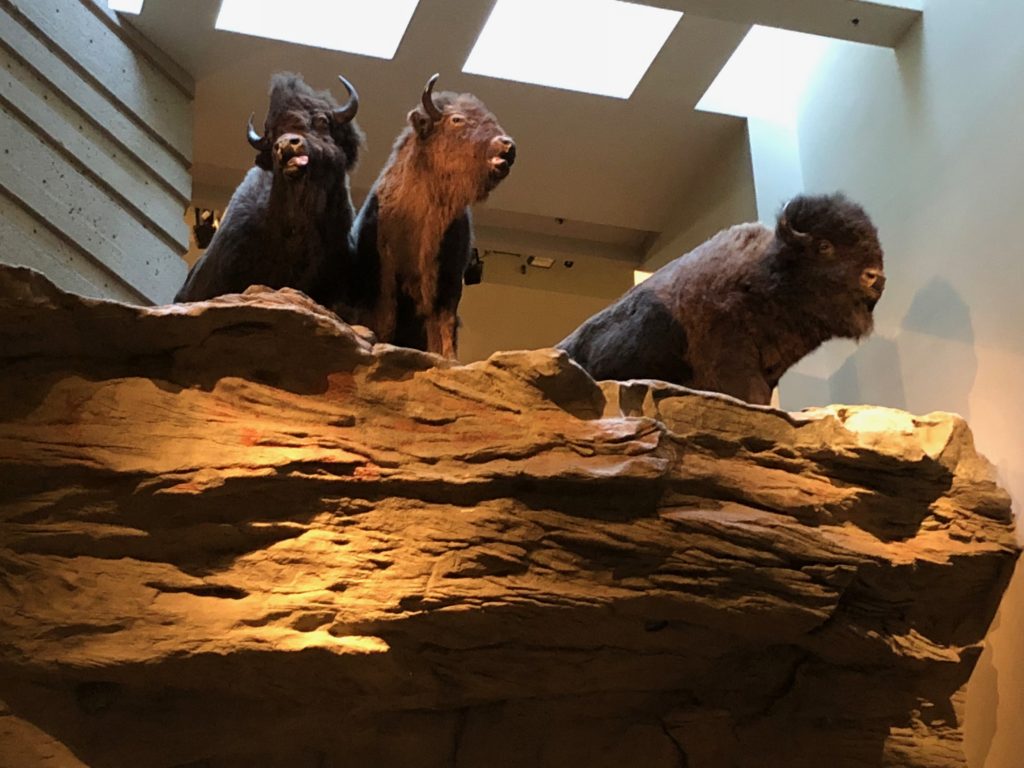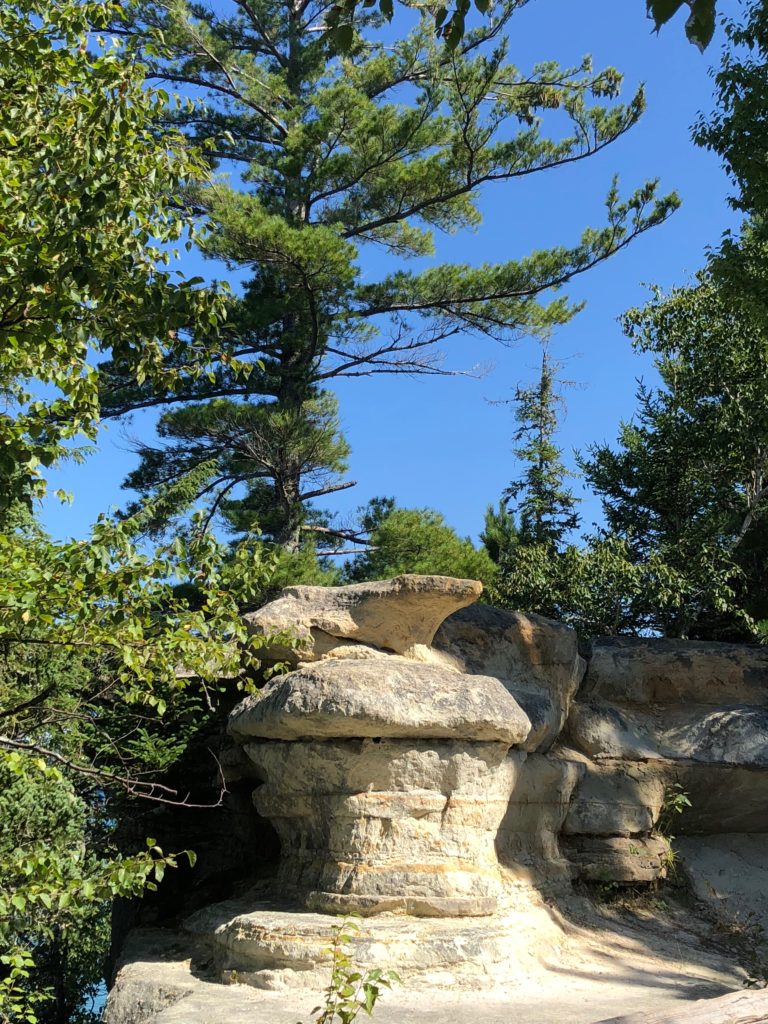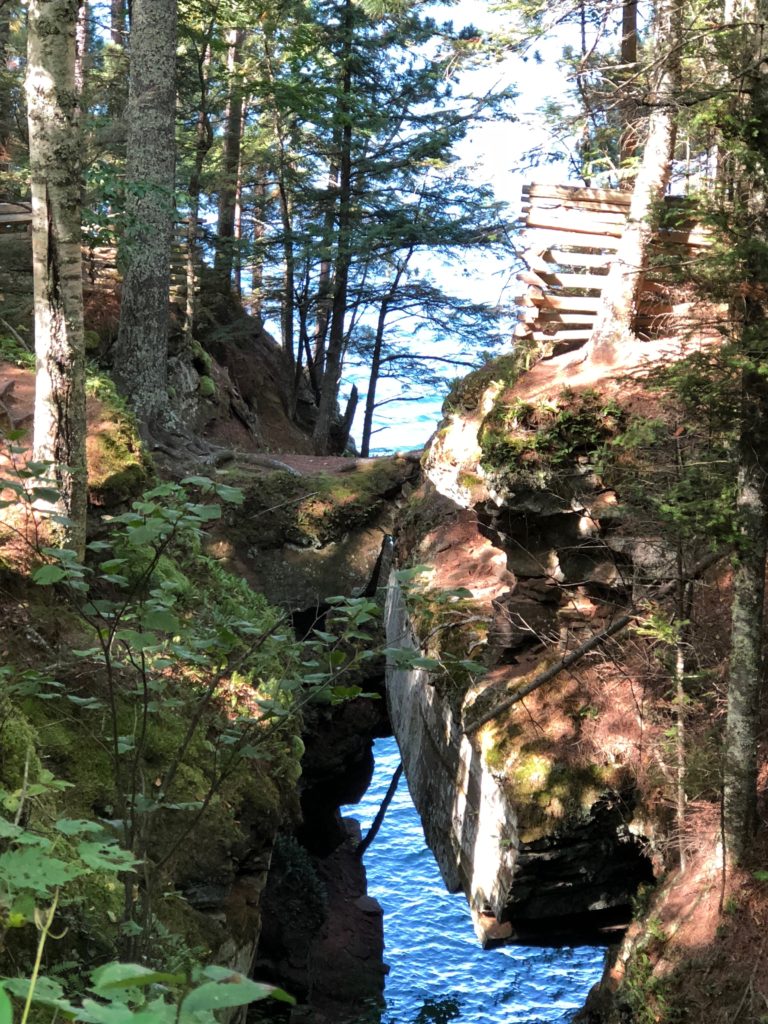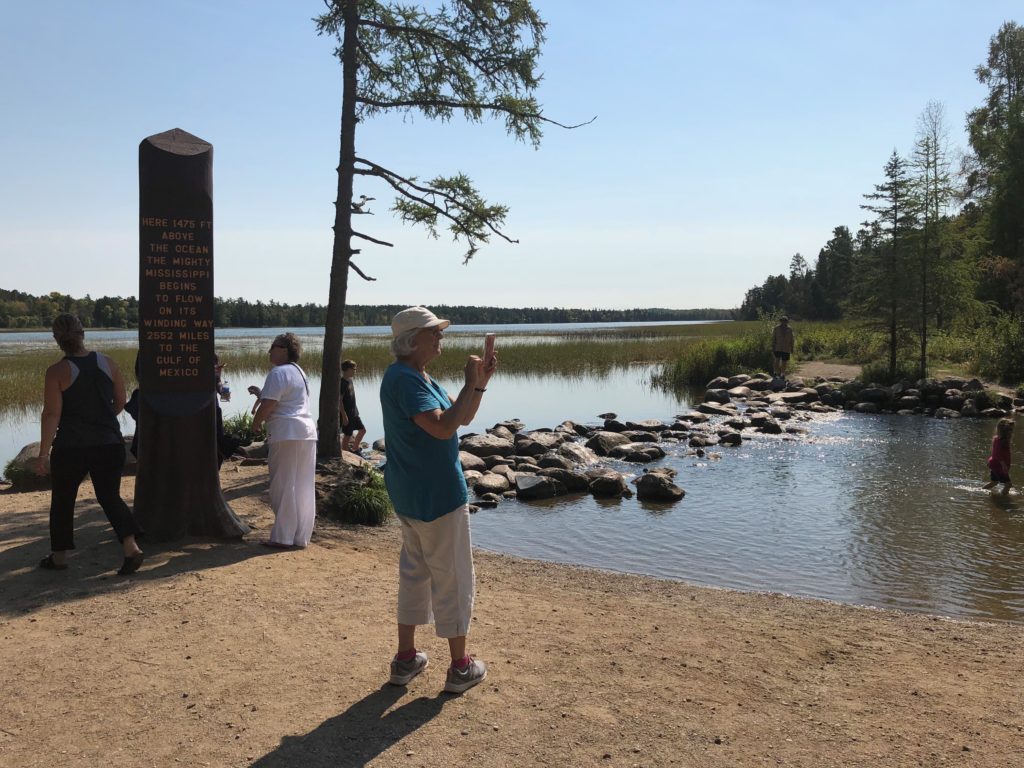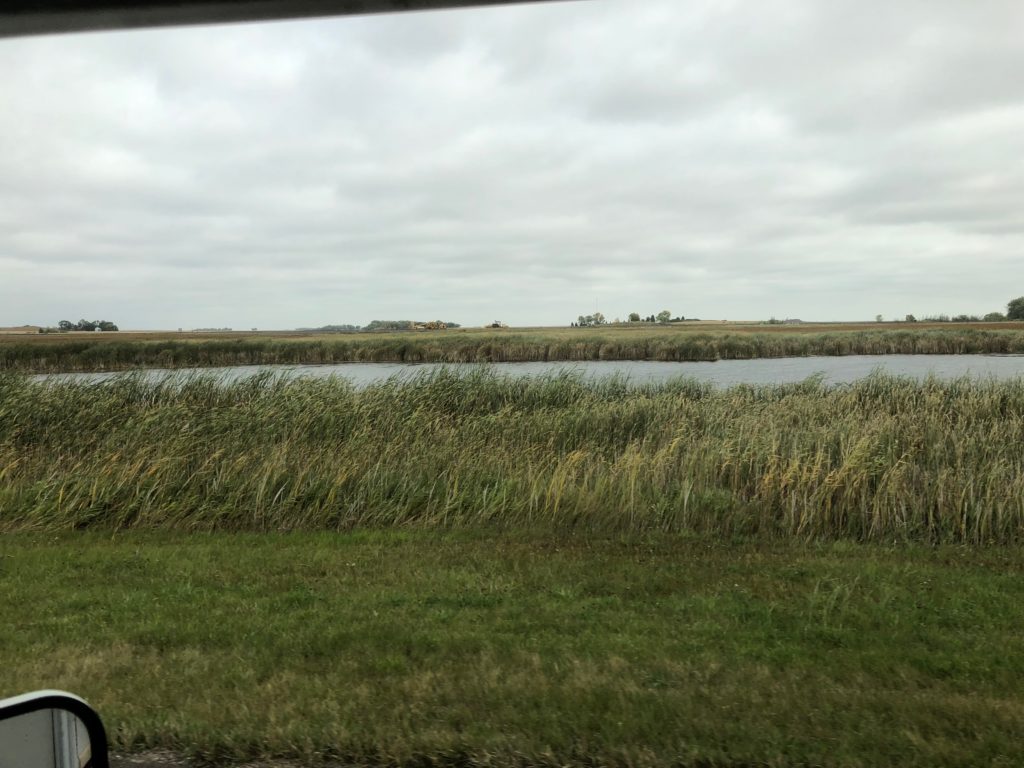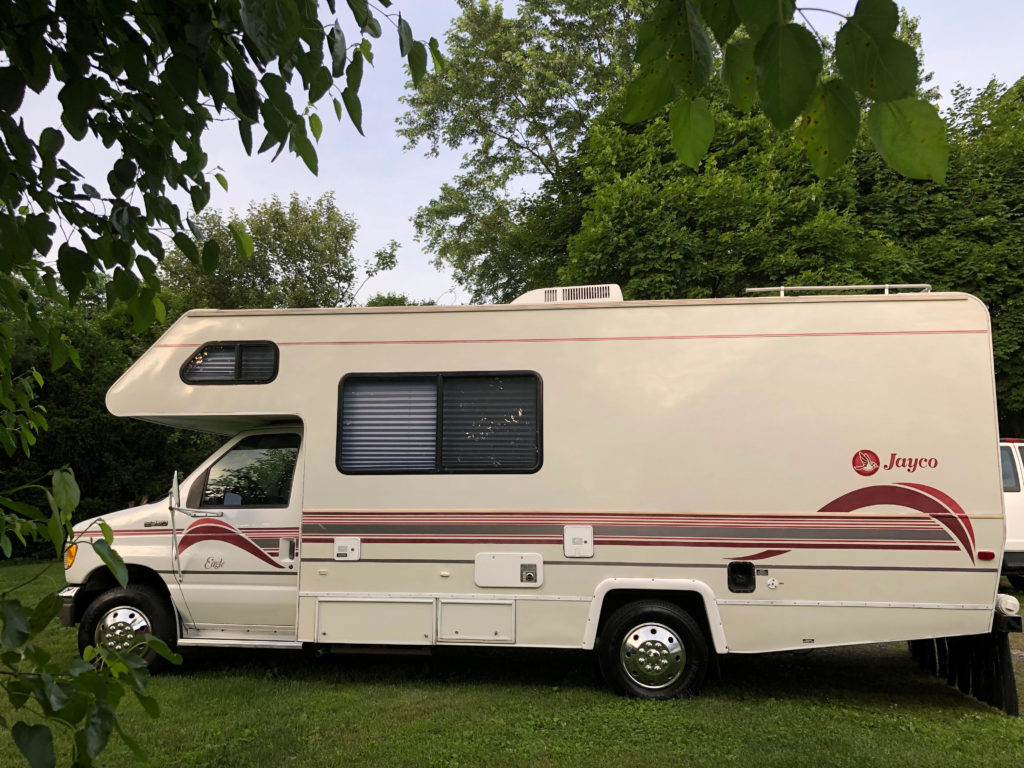It’s a beautiful sunny day. Felicity finds a place four miles from here, on the coast of course, where she wants to paint. I’m still feeling a bit tired so I’ll be happy to rest.
The GPS takes us to the place, up extremely steep hills with extremely tight turns until we reach a single lane dirt track that goes down hill. It ends with a Private No Entry sign.
I back laboriously to a place where I can, with considerable difficulty, turn and Felicity says she’s given up on painting today. “Let’s go to the Creamery Museum”. On the way I stop at a tiny turnoff overlooking the spectacular bay. Felicity gets out to take pictures and I follow. We both take many pictures.

“It’s too bright and hazy. I can’t paint that today”. So we set off again. I see a turning to a boat launch and take it. Felicity says she just doesn’t have it in her to paint today. “I’ll just get out and look, though”.
She’s gone quite a while. I see her sitting on a bench looking out at the ocean and I get out to take more pictures. An old guy in a boat has just come in. He’s sitting waiting for the boat owner to bring his truck and trailer to haul the boat out. It’s most picturesque.

Felicity returns. “I’m just going to have to do it, aren’t I?” I confirm that destiny is calling, she collects her backpack and bravely sets off, then I get out my lunch stuff. There’s no longer any pleasure in eating but it keeps me alive and I do like that.
I read more of Barry Maitland’s “The Chalon Heads”. It’s the first of his books I’ve read, an excellent mystery.
Felicity returns feeling rejuvenated. She’s pleased with her painting and she should be. “Let’s go to the Creamery now” she says and off we go. She’ll have lunch there while I get gas and beer and check out the nearby Goodwill store for more books.
It turns out liquor stores don’t sell beer in Oregon. You go to the supermarket for that. I guess the logic is it’s a staple of existence. A man with no legs is sitting across from the supermarket. I give him a few dollars, something I never used to do.
At Goodwill I find two hardcover novels at $6.99 each and realize I’m spending more on them than I gave the man with no legs. I need to do a lot more work on miserliness.
We return to the campsite. Felicity goes to paint another picture. I listen to more of Zen And. I’m hooked now.
Next day – Felicity finds a place on the coast about an hour south where she wants to paint. The GPS takes us along the coast then inland through the hills where a few small scale beef cattle ranches have been carved out of the pine forest.
Every so often there’s an area of clear cutting. One, surprisingly high, is now a giant sand dune.
Our destination turns out to be a resort. Painting isn’t really practical here so we go for a walk on the beach where we’re joined by a group on horses, then we sit in the sun. I’m coughing today. It’s quite windy on the beach so maybe something in the air is making it worse.

Felicity is still recovering from her cold. She doesn’t feel up to painting now. We’ll head inland and explore. There’s a woolen mill museum that looks worth visiting.
East of the mountains the land is first rolling then flat. We’re back in arable farming country. As we bowl along the highway I realize I can start using cruise control again. But it doesn’t work. That will help to diagnose the remaining problem. Neither the speedometer, odometer nor cruise control work. Everything else is okay although the transmission still hesitates briefly before engaging gear and it tends to slam into gear.
There’s an orientation film at the museum that tells the area’s history. Methodist missionaries came shortly before the Oregon Trail was established. Their mission was to “educate the Indians and teach them agriculture” while bringing them to Christ.
The native Americans were in poor shape to stand up for themselves because an estimated 90% of them had already succumbed to diseases brought by fur trappers.
We tour the woolen mill, which is similar in many ways to the cotton mill where my great grandfather, John Henry, worked in England but my enjoyment is increasingly hampered by coughing. There’s a wonderful smell of sheep. I have such happy memories of ours. The coughing grows almost continuous so at last I sit and rest while Felicity continues to study the exhibits.
We drive on to a campsite near Corvallis where the previous owners of our Newtown CT sheep farm, in their case a horse farm, moved. I Bullfrog myself. It’s hard to believe it’s beneficial not the reverse.
Next day – I’m emailed by a woman who, while researching her family history, found my website where I posted the Sidwell History I wrote a few years ago. Her grandmother was the sister of the mother of my dad’s cousin Richard who felt like a brother to him. Her aunt has happy memories of Richard and Gill. We chat and she sends photos. I’ll put her in touch with Richard and Gill’s daughter, Amanda.
I Bullfrog myself again then we start driving to Bend to visit Elaine who I worked with at DunsGate. The road is at first flat and leads through mostly arable country with a few cattle farms and a couple of sheep farms. Then we reach the mountains.
Up, up we go through mixed pine and deciduous forest beside what must at times be a raging torrent but is now almost dry. There’s been a drought here for the last four years. Trees beside the river bed are still thickly encrusted with moss.

As we continue up, up I recall a trek where we made a very long climb. I asked Dhiren, our guide, from time to time if we were near the top. He smiled each time and said yes. At last I concluded “the top” is a metaphysical concept with no parallel in nature, not in the Himalayas at any rate.
The mountain sides further up are covered with dead trees. There was evidently a big fire here. We stop where there’s a description and learn it was in fact a gigantic fire that spread over 90,000 acres. There’s a short description of why such a fire could happen.
These forests had a crown when only native Americans lived here that shaded the ground. That meant the forest was relatively open, growing grass not shrubs and saplings. Then the settlers came with tools to “manage” the forest. The pines were grown closer and closer together. Lightning strikes that used to cause small fires had so much more to combust, generating more and hotter flames whose roaring updraft accelerated and spread the wildfire.
Our predecessors were such arrogant people. Their sense of entitlement and contempt for others continue to be a deep stain on our culture. But we have learned some things and we can keep working to grow more aware.
Next Day – We’re going to visit Elaine in Bend today and we’ll probably stay the night.
Doma’s mom and her community evaluate a person’s heart as well as their brain. Both must be strong if you’re to depend on someone, if they are to be your true friend.
Elaine and I depended on each other when we worked together in New York but Felicity is apprehensive that we will quickly run out of topics for conversation because she only met Elaine once, it’s almost twenty years since Elaine and I last met, and I can now only communicate by writing.
We arrive and start talking and although there’s a lot to catch up on, it feels like only a few months since the last time. We talk about our families, how Elaine’s co-housing community works, Colorado and, along the way, what we value. No need to reminisce about when we worked together and no need to avoid it either. Felicity and Elaine enjoy each other very much. It’s a lovely time.
Next day – Elaine suggests we visit Crater Lake. We drive south through forests that have been thinned to become as they were before logging began. I couldn’t live here for fear of forest fires. But now I say that I realize I’d have said the same about living on a sand bank at the ocean’s edge.
It’s mostly single lane but it’s a straight and flat highway. Henry would thank me if he could. Or maybe not because he’d know it couldn’t last. As indeed it doesn’t. We turn west and start to climb. I love the hot, bright sun and the sharp contrasts in this light.
There’s a pull-off when we’re in the Crater Lake park. We walk up a sandy bank and with no warning, suddenly there below us is a great body of brilliantly blue water. We’re on a volcano’s rim. It’s so beautiful! Breath talking.


Literally breath taking for me, in fact. The oxygen content is lower at 7,000 to 8,000 feet above sea level and, because my diaphragm now pulls in less air, I feel the way I did at 13,000 feet on my first Himalayan trek fifteen years ago.
I was a bit worried then but with that experience I know now to adjust the demand I place on my muscles to a level at which my lungs can supply enough oxygen. I was fine on subsequent treks at 19,000 feet and it’s possible to summit Everest without supplementary oxygen ten thousand feet higher. You do have to have intact lungs, though. Ed Hillary couldn’t go higher than 10,000 feet on his last visit to Nepal.
“Shall we do the 30 mile rim drive? What do you think?” asks Felicity. I do think for a moment but of course I give her the thumbs up. It can take quite a while to drive 30 miles if you keep stopping to marvel at the view and take photographs. We’re lucky to be here at this time of year because school holidays are over. There must be huge crowds in summer.
Half way round we stop stopping at every view point. We’re both getting tired and we’ll have to find a campsite. Felicity studies the map while I nurse Henry up and down the very steep road. “We shouldn’t go the way I originally wanted” she says “because now I’ve looked at the contour map I see the road is very steep and winding. We should go back the way we came in, then south or west. South is easier but west gets us closer to the coast.”
I’m feeling very happy and sign that we should go west. The very dry air is making me cough but that will pass. My BiPap slightly moistens the air so I’ll be better in the morning.
Next day – After going to bed very early and sleeping long I feel much better. When my nose finishes draining and the coffee I added to my formula has taken effect I feel great.
Felicity wants to see waterfalls near this campsite in Prospect. The signs at what seem to be viewing spots are either non-existent or confusing. We start down a steep footpath with the sound of falling water in the distance.
“Are you really up for this?” Felicity asks. “It will be a hard climb back.” I’m doing okay so far. “I’m up for it if you are” I write. Long pause. “I’m not sure I am, and I really think it’s too much for you.” “Okay”, I gesture, pointing back uphill and start walking.
I have to stop for breath quite soon. Then I have to stop again and breathe for a long time before starting again. I have to stop several more times on the short ascent. My legs are okay, I just can’t get enough breath.
That’s when I remember the other thing that happens at high altitude. Your judgment turns to shit.
The first part of the drive is through hay fields and pastures liberally sprinkled with deciduous trees whose leaves are every shade of yellow and gold, with just the occasional burst of red and even more rare, a tree whose leaves are still deep green. Everything is vibrant in the strong sun. So much energy here, so beautiful and invigorating.
The steep hillsides enclosing the valley are forested with a mix of pine and deciduous trees.
Up we go into the mountainous hills then down, down until we follow the Smith River along an exceptionally winding road cut into the rock beside the river. All I can see is the road just ahead.
Then we’re in a forest of truly gigantic trees, old growth redwoods. They are so tall and of such huge diameter. They block that strong sun so it’s actually dark in here. I feel humbled by their presence.

Our campsite also has redwoods and is quite close to the ocean. A mournful lighthouse fog horn is almost the only sound.








